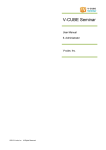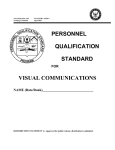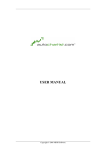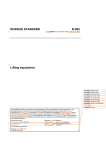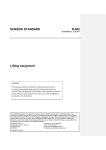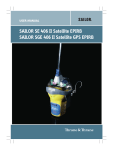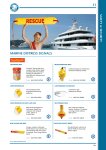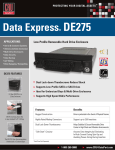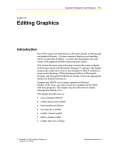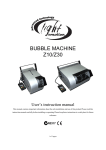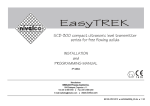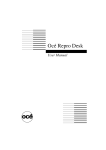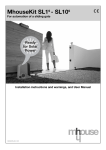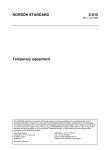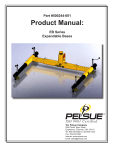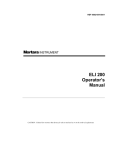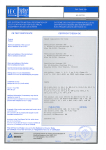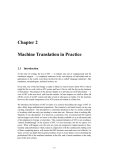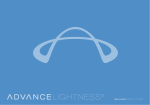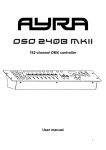Download KTF/TFSK Seminar on NORSOK R
Transcript
KTF/TFSK Seminar on NORSOK R-002 Lifting Equipment Annex A - Launching and recovery appliances for life saving equipment Annex I - Elastic pennant for lifting rescue boat with offshore crane Gunnar Matre, Det Norske Veritas 5-6 January 2013 AGENDA General application Group overview Common requirements A.1 Appliances for free fall lifeboats A.2 Appliances for lifeboats launched by falls and a winch A.6 Appliances for rescue boats KTF/TFSK Seminar on NORSOK R-002 Lifting Equipment 5-6 January 2013 © Det Norske Veritas AS. All rights reserved. 2 General application General Scope Relation to Definitions machinery directive KTF/TFSK Seminar on NORSOK R-002 Lifting Equipment 5-6 January 2013 © Det Norske Veritas AS. All rights reserved. 3 Interface with NDM853 Annex A – General application GENERAL Requirements of Annex A apply in addition to the requirements stated in sections 1-5 in the main part of the standard Covers suspension and hang-off points for lifesaving equipment and means of connection and release systems that are integral part of the life saving equipment Annex A does not cover: - outfitting and other technical facilities that are not related to launching, hang-off or recovery of the life saving equipment Lifting accessories: - Annex C applies in addition to Annex A Hand gear for recovery of survival crafts and rescue boats - Hand gear according to LSA code 6.1.2.6 is not required by R-002 (but not forbidden either) KTF/TFSK Seminar on NORSOK R-002 Lifting Equipment 5-6 January 2013 © Det Norske Veritas AS. All rights reserved. 4 Annex A – General application GENERAL (cont.) Mechanical joining devices of hinged type (“connecting links”) shall not be used as hang off equipment or as means of connection belonging to any kind of life saving equipment or launching/recovery appliances for such equipment. KTF/TFSK Seminar on NORSOK R-002 Lifting Equipment 5-6 January 2013 © Det Norske Veritas AS. All rights reserved. 5 Annex A – General application SCOPE Chapter 1: “(…) This standard is also valid for (…)”: - Launching and recovery appliances for life saving equipment, with and without lifting function - Means of connection and release systems that are integrated parts of life saving equipment, as well as their anchorage in the life saving equipment; A.1.1 “(…) This annex contains:” - technical requirements concerning lifting and lowering facilities of launching and recovery appliances for life saving equipment A.1.1 “(…) This annex also covers:” - suspension and hang-off points for lifesaving equipment and means of connection and release systems that are integral part of the life saving equipment KTF/TFSK Seminar on NORSOK R-002 Lifting Equipment 5-6 January 2013 © Det Norske Veritas AS. All rights reserved. 6 Annex A – General application MACHINERY DIRECTIVE V.S. NORSOK R-002 COMMON OVERALL REQUIREMENTS PRINCIPLES OF SAFETY INTEGRATION RISK ASSESSMENT PRIORITY OF RISK REDUCING MEASURES INSTRUCIONTS (USER MANUAL / MARKING) EQUIPMENT MD R-002 Lifting appliances /winches YES YES Lifting accessories YES YES Skidding track NO YES Load carrying structure NO* YES Foundation NO YES Parts of life boats / rescue boats NO YES *MD Applies to load carrying structure integrated in lifting machinery KTF/TFSK Seminar on NORSOK R-002 Lifting Equipment 5-6 January 2013 © Det Norske Veritas AS. All rights reserved. 7 Annex A – General application DEFINITIONS 3.1.15 launching and recovery appliances: “lifting appliance for lifesaving equipment” To be understood as: - When the term “lifting appliance” (or “lifting equipment) is referred to in main part of standard, it also covers “Launching and recovery appliances”. Life saving equipment (not defined) Evacuation equipment: Life boats, life rafts, Rescue equipment: Rescue boats (MOB boats), personnel transfer carriers KTF/TFSK Seminar on NORSOK R-002 Lifting Equipment 5-6 January 2013 © Det Norske Veritas AS. All rights reserved. 8 Annex A – General application DEFINITIONS (cont.) 3.1.29 Means of connection mechanical parts (e.g. hooks, links, rings, etc.) intended for connection of the life saving equipment to the launching and recovery appliance - Integral parts of launching/recovery appliance - Integral parts of life saving equipment 3.1.40 Release system combination of release mechanism and activation system 3.1.39 Release mechanism parts of the means of connection that are moveable for the purpose of disconnecting the life saving equipment from its launching and recovery appliance 3.1.1 Activation system interconnected parts necessary for powered or manual opening of the release mechanism, including the power supply and control system or manual control device system KTF/TFSK Seminar on NORSOK R-002 Lifting Equipment 5-6 January 2013 © Det Norske Veritas AS. All rights reserved. 9 Annex A – General application INTERFACE WITH NMD REGULATION 4 July 2007 No. 853 Requirements in LSA-code become applicable through references to NMD Regulation 853 References given to NMD 853 shall only include requirements relevant for: - launching and recovery appliances hang-off relief arrangement release systems means of connections and their attachment to the life saving equipment Other NMD requirements to life saving equipment are not within the scope of R-002 In case of conflict: - the most stringent requirements for structural and mechanical strength apply - otherwise the requirements of this NORSOK standard apply KTF/TFSK Seminar on NORSOK R-002 Lifting Equipment 5-6 January 2013 © Det Norske Veritas AS. All rights reserved. 10 Annex A – General application INTERFACE WITH NMD REGULATION 4 July 2007 No. 853 (cont.) § 8 General requirements for life saving appliances and launching arrangements - a) certified materials, - b) welding - c) launching arrangements designed for use in areas with a daily mean temperature considerably lower than 0 °C - d) electrical installations, IP protection, Voltage not exceed 230V - f) Lifeboats, liferafts and rescue boats shall be stowed at a safe distance from defined hazardous areas - The release mechanisms of all lifeboats of the same type on the unit shall be identical KTF/TFSK Seminar on NORSOK R-002 Lifting Equipment 5-6 January 2013 © Det Norske Veritas AS. All rights reserved. 11 Annex A – General application INTERFACE WITH NMD REGULATION 4 July 2007 No. 853 (cont.) §11, 1st paragraph: - LSA Code para. 6.1.1, 6.1.2 and 6.1.4 Additionally, the following general requirements shall apply: a) Securing of life-saving appliances when stowed, b) Hydraulic systems in accordance with a recognized standard, c) Steel wires, chains, shackles, etc. shall be certified. d) Swivels, shackles, turnbuckles and discs shall be secured. e) At least 3 turns of steel wire on the winch drum More specific NMD requirements referred to under each equipment group KTF/TFSK Seminar on NORSOK R-002 Lifting Equipment 5-6 January 2013 © Det Norske Veritas AS. All rights reserved. 12 AGENDA General application Group overview Common requirements A.1 Appliances for free fall lifeboats A.2 Appliances for lifeboats launched by falls and a winch A.6 Appliances for rescue boats KTF/TFSK Seminar on NORSOK R-002 Lifting Equipment 5-6 January 2013 © Det Norske Veritas AS. All rights reserved. 13 Annex A – Group overview KTF/TFSK Seminar on NORSOK R-002 Lifting Equipment 5-6 January 2013 © Det Norske Veritas AS. All rights reserved. 14 AGENDA General application Group overview Common requirements A.1 Appliances for free fall lifeboats A.2 Appliances for lifeboats launched by falls and a winch A.6 Appliances for rescue boats KTF/TFSK Seminar on NORSOK R-002 Lifting Equipment 5-6 January 2013 © Det Norske Veritas AS. All rights reserved. 15 Annex A – Common requirements Operational limitations • LS / NLS conditions • Speed requirements • Design temperature Secondary power/control Proof of competence • EN 13001-series standard • Loads and load effects • Dynamic amplification factors • Load tables • Limit states • Strength proportions Securing arrangement Procedures Motion limiters Brakes Testing • Primary brake • Backup brake KTF/TFSK Seminar on NORSOK R-002 Lifting Equipment 5-6 January 2013 © Det Norske Veritas AS. All rights reserved. 16 Annex A – Common requirements Operational limitations • LS / NLS conditions • Speed requirements • Design temperature Secondary power/control Proof of competence • EN 13001-series standard • Loads and load effects • Dynamic amplification factors • Load tables • Limit states • Strength proportions Securing arrangement Procedures Motion limiters Brakes Testing • Primary brake • Backup brake KTF/TFSK Seminar on NORSOK R-002 Lifting Equipment 5-6 January 2013 © Det Norske Veritas AS. All rights reserved. 17 Annex A – Common requirements OPERATIONAL LIMITATIONS NLS (Non-life saving) condition: - condition for operation during installation and maintenance - design criteria and operational limitation LS (Life saving) condition: - condition for operation during a real life saving situation, i.e. evacuation or rescue - design criteria, but not operational limitation NLS and LS conditions are defined by: - environmental conditions in terms of max wind speed and max significant wave height - operational situations as sidelead and offlead - max static angle of heel for the installation in the damaged stability condition Design temperature -20 °C (unless otherwise agreed) KTF/TFSK Seminar on NORSOK R-002 Lifting Equipment 5-6 January 2013 © Det Norske Veritas AS. All rights reserved. 18 Annex A – Common requirements OPERATIONAL LIMITATIONS (cont.) KTF/TFSK Seminar on NORSOK R-002 Lifting Equipment 5-6 January 2013 © Det Norske Veritas AS. All rights reserved. 19 Annex A – Common requirements OPERATIONAL LIMITATIONS (cont.) Hoisting and lowering velocities Except for Group A.2 in LS conditions, required velocities are minimum values KTF/TFSK Seminar on NORSOK R-002 Lifting Equipment 5-6 January 2013 © Det Norske Veritas AS. All rights reserved. 20 Annex A – Common requirements Operational limitations • LS / NLS conditions • Speed requirements • Design temperature Secondary power/control Proof of competence • EN 13001-series standard • Loads and load effects • Dynamic amplification factors • Load tables • Limit states • Strength proportions Securing arrangement Procedures Motion limiters Brakes Testing • Primary brake • Backup brake KTF/TFSK Seminar on NORSOK R-002 Lifting Equipment 5-6 January 2013 © Det Norske Veritas AS. All rights reserved. 21 Annex A – Proof of competence STRUCTURAL AND MECHANICAL STRENGTH Apply the principles of the limit state method described in 5.7 Launching and recovery appliances: - structural members Machinery Ropes Rope reeving components Means of connection Life saving equipment: - Means of connection - Anchorage in hull KTF/TFSK Seminar on NORSOK R-002 Lifting Equipment 5-6 January 2013 © Det Norske Veritas AS. All rights reserved. 22 Annex A – Proof of competence EN 13001-SERIES STANDARD Based on principles in Eurocode, EN 1990 “Basis of structural design” Based on basic crane design load combinations as known from F.E.M. 1.001 EN 13001-1: General principles and requirements EN 13001-2: Load actions EN 13001-3.xx (the limit states) KTF/TFSK Seminar on NORSOK R-002 Lifting Equipment 5-6 January 2013 © Det Norske Veritas AS. All rights reserved. 23 Annex A – Proof of competence BASIC CRANE LOADS - EN 13001 Regular loads Exceptional loads - Loads caused by hoisting a grounded load under exceptional circumstances - Loads due to out-of-service wind - Test loads - Loads due to buffer forces - Loads due to tilting forces - Loads caused by emergency cut-out - Loads caused by failure of mechanism or components - Loads caused by external excitation of crane foundation - Loads caused by erection and dismantling - Hoisting and gravity effects on the mass of the crane - Inertial and gravity effects acting vertically on the hoist load - Loads caused by travelling on uneven surface - Loads caused by acceleration of all crane drives - Loads induced by displacements Occasional loads - Loads due to in-service wind Snow and ice loads Loads due to temperature variation Loads caused by skewing KTF/TFSK Seminar on NORSOK R-002 Lifting Equipment 5-6 January 2013 © Det Norske Veritas AS. All rights reserved. 24 Annex A – Proof of competence CRANE LOAD COMBINATIONS EN 13001-2 Table 10 – selected loads: - Combination A – Regular loads for a crane under normal operation - Combination B – Regular loads combined with occasional loads - Combination C – Regular loads combined with occasional loads and exceptional loads Selected loads multiplied with individual partial safety factors (γp) and dynamic factors (φ) KTF/TFSK Seminar on NORSOK R-002 Lifting Equipment 5-6 January 2013 © Det Norske Veritas AS. All rights reserved. 25 Annex A – Proof of competence EN 13001-2, TABLE 10 KTF/TFSK Seminar on NORSOK R-002 Lifting Equipment 5-6 January 2013 © Det Norske Veritas AS. All rights reserved. 26 Annex A – Proof of competence EN 13001-2, TABLE 10 (cont.) KTF/TFSK Seminar on NORSOK R-002 Lifting Equipment 5-6 January 2013 © Det Norske Veritas AS. All rights reserved. 27 Annex A – Proof of competence LOAD TABLES IN R-002 ANNEX A Groups of launching appliances fundamentally different from cranes and each other Wind conditions for cranes not suitable for launching appliances - In-service condition - Out-of-service condition Need for “translation” of Table 10 from EN 13001-2 to NORSOK R-002 Annex A Resulting in tables - A.3: Group A.1 - Lifeboat in stowed position and launched by primary means of launching A.4: Group A.1 - Lowering by secondary means of launching and hoisting by means of retr. A.5: Group A.2 - Launching appliances for lifeboats launched by falls and a winch A.9: Group A.6 - Launching appliances for rescue boats ‘ KTF/TFSK Seminar on NORSOK R-002 Lifting Equipment 5-6 January 2013 © Det Norske Veritas AS. All rights reserved. 28 Annex A – Proof of competence DYNAMIC FACTORS Minimum: φ2 ≥ 1,5 Maximum, for normal pick-up at sea: - Persons standing: - Persons sitting: φ2 ≤ 2,5 φ2 ≤ 4,0 General formula for pick-up at sea: Based on established formula for offshore cranes picking up load from boat deck Reduction factor (displacement factor), k∆, key to optimalisation KTF/TFSK Seminar on NORSOK R-002 Lifting Equipment 5-6 January 2013 © Det Norske Veritas AS. All rights reserved. 29 Annex A – Proof of competence RISK COEFFICIENT, γn For lifting/lowering persons: γn = 1,5 Resulting load effects to be multiplied by risk coefficient for: - all load carrying structure - machinery components including wire ropes and chains - means of connection and their anchorage in the life saving equipment Risk coefficient implemented in load tables in Annex A KTF/TFSK Seminar on NORSOK R-002 Lifting Equipment 5-6 January 2013 © Det Norske Veritas AS. All rights reserved. 30 Annex A – Proof of competence LATERAL LOADS ON MEANS OF CONNECTION means of connection that are rigidly connected to the life saving equipment out-of-plane force shall be applied in the most unfavourable direction not less than 10% of the maximum static weight act at the point of contact with the means of connection shall be considered as mass of the hoist load in terms of dynamic factors and partial safety factors KTF/TFSK Seminar on NORSOK R-002 Lifting Equipment 5-6 January 2013 © Det Norske Veritas AS. All rights reserved. 31 Annex A – Proof of competence LIMIT STATES Load effects to be less than limit design resistance Limit design resistance: Rk = Characteristic resistance γR = Resistance factor KTF/TFSK Seminar on NORSOK R-002 Lifting Equipment 5-6 January 2013 © Det Norske Veritas AS. All rights reserved. 32 Annex A – Proof of competence LIMIT STATES (simplified) Characteristic resistance Resistance factor Steel structures Yield limit EN 13001-3-1 Aluminium structures Yield limit EN 1999-1-1 Mechanisms FEM 1.001 (ref. R-002 clause 5.7.5) Composite structures DNV-OS-E406 Sec. 6 C Steel wire ropes Breaking strength CEN/TS 13001-3-2 (min. 2,0) Chains Breaking strength 1,8 Fibre ropes, slings, webbings Breaking strength 2,3 Means of connection – metallic components Breaking strength 1,8 Means of connection – Structural steel Yield limit EN 13001-3-1 KTF/TFSK Seminar on NORSOK R-002 Lifting Equipment 5-6 January 2013 © Det Norske Veritas AS. All rights reserved. 33 Annex A – Proof of competence STRENGTH PROPORTIONS Group A.2 and A.6 Risk of accidental overloading Calculations showing that the launching appliance will not be detached from the installation before other load bearing parts have collapsed KTF/TFSK Seminar on NORSOK R-002 Lifting Equipment 5-6 January 2013 © Det Norske Veritas AS. All rights reserved. 34 Annex A – Common requirements Operational limitations • LS / NLS conditions • Speed requirements • Design temperature Secondary power/control Proof of competence • EN 13001-series standard • Loads and load effects • Dynamic amplification factors • Load tables • Limit states • Strength proportions Securing arrangement Procedures Motion limiters Brakes Testing • Primary brake • Backup brake KTF/TFSK Seminar on NORSOK R-002 Lifting Equipment 5-6 January 2013 © Det Norske Veritas AS. All rights reserved. 35 Annex A – Common requirements MOTION LIMITERS All groups except A.5 EN 12077-2 Hoisting motion and any other recovery motions - to prevent hoisting/moving beyond the stowed position Lowering motion - to prevent rope pay-out after the life saving equipment is seaborne Brakes shall be applied when motion limiters are activated Means to prevent excessive pulling forces in the hoist rope(s) caused by hoisting the life saving equipment against an obstruction in the event of failure of the motion limiter for the upper position: - a backup motion limiter in accordance with EN 12077-2, or - limiting the pulling force in the winch rope, e.g. by limiting hydraulic pressure KTF/TFSK Seminar on NORSOK R-002 Lifting Equipment 5-6 January 2013 © Det Norske Veritas AS. All rights reserved. 36 Annex A – Common requirements Operational limitations • LS / NLS conditions • Speed requirements • Design temperature Secondary power/control Proof of competence • EN 13001-series standard • Loads and load effects • Dynamic amplification factors • Load tables • Limit states • Strength proportions Securing arrangement Procedures Motion limiters Brakes Testing • Primary brake • Backup brake KTF/TFSK Seminar on NORSOK R-002 Lifting Equipment 5-6 January 2013 © Det Norske Veritas AS. All rights reserved. 37 Annex A – Common requirements BRAKES Brake (primary brake) as required by 5.7.6 Backup brake, when specified for the particular group - designed according to the same requirements given for the primary brake given in 5.7.6 - the backup brake shall be of a different type or make than the primary brake - shall preferably act directly on the winch drum, but a load path fully independent from the primary brake will be considered acceptable Primary and backup brakes shall be arranged for individual testing. Where hydraulic cylinders are used, two independent cylinders shall be provided for each function such that one cylinder is capable to stop and hold the load, in case of a failure of the other cylinder KTF/TFSK Seminar on NORSOK R-002 Lifting Equipment 5-6 January 2013 © Det Norske Veritas AS. All rights reserved. 38 Annex A – Common requirements SECONDARY INDEPENDENT POWER AND CONTROL SYSTEM Equivalent with emergency operation system (EOS) according to 5.15.3 Required for the powered movements Shall not be affected by failures in the primary systems The secondary independent power system shall have sufficient capacity to hoist and lower the same load as the primary power system. KTF/TFSK Seminar on NORSOK R-002 Lifting Equipment 5-6 January 2013 © Det Norske Veritas AS. All rights reserved. 39 Annex A – Common requirements Operational limitations • LS / NLS conditions • Speed requirements • Design temperature Secondary power/control Proof of competence • EN 13001-series standard • Loads and load effects • Dynamic amplification factors • Load tables • Limit states • Strength proportions Securing arrangement Procedures Motion limiters Brakes Testing • Primary brake • Backup brake KTF/TFSK Seminar on NORSOK R-002 Lifting Equipment 5-6 January 2013 © Det Norske Veritas AS. All rights reserved. 40 Annex A – Common requirements SECURING ARRANGEMENT For training and maintenance purposes, when the life saving equipment is not intended to be launched A fail-safe securing arrangement including an interlock system is to be provided to prevent unintended operation or release The securing arrangement including attachments to structure shall be durably marked for identification and for prevention of misuse Not the same as hang-off relief arrangement, men hang-off relief arrangement may be used as securing arrangement KTF/TFSK Seminar on NORSOK R-002 Lifting Equipment 5-6 January 2013 © Det Norske Veritas AS. All rights reserved. 41 Annex A – Common requirements Operational limitations • LS / NLS conditions • Speed requirements • Design temperature Secondary power/control Proof of competence • EN 13001-series standard • Loads and load effects • Dynamic amplification factors • Load tables • Limit states • Strength proportions Securing arrangement Procedures Motion limiters Brakes Testing • Primary brake • Backup brake KTF/TFSK Seminar on NORSOK R-002 Lifting Equipment 5-6 January 2013 © Det Norske Veritas AS. All rights reserved. 42 Annex A – Common requirements PROCEDURES Clear and unambiguous procedures shall be provided for - primary means of launching, secondary means of launching, maintenance and installation facilities, life saving operations (i.e. evacuation or rescue) Easily understandable operations instruction and permanent sign plates shall be posted at the launching station, in accordance with: - EN 12644-2 - IMO Resolution A.760 (18), as amended by IMO resolution MSC.82 (70) KTF/TFSK Seminar on NORSOK R-002 Lifting Equipment 5-6 January 2013 © Det Norske Veritas AS. All rights reserved. 43 Annex A – Common requirements Operational limitations • LS / NLS conditions • Speed requirements • Design temperature Secondary power/control Proof of competence • EN 13001-series standard • Loads and load effects • Dynamic amplification factors • Load tables • Limit states • Strength proportions Securing arrangement Procedures Motion limiters Brakes Testing • Primary brake • Backup brake KTF/TFSK Seminar on NORSOK R-002 Lifting Equipment 5-6 January 2013 © Det Norske Veritas AS. All rights reserved. 44 Annex A – Common requirements TESTING Requirements only provided for group A.1 at present Prototype testing - Qualifies a design - Often destructive test Production tests - To be performed at the manufacturer’s site prior to shipment to the final installation Installation tests - The lifeboat shall be tested in combination with its dedicated launching appliance - Installation tests are to be performed after being installed at the final installation Production tests and installation tests are intended to be performed on each individual produced unit in order to demonstrate a certain quality or performance All tests to be documented by detailed procedures with acceptance criteria and test reports with test results KTF/TFSK Seminar on NORSOK R-002 Lifting Equipment 5-6 January 2013 © Det Norske Veritas AS. All rights reserved. 45 KTF/TFSK Seminar on NORSOK R-002 Lifting Equipment 5-6 January 2013 © Det Norske Veritas AS. All rights reserved. 46 KTF/TFSK Seminar on NORSOK R-002 Lifting Equipment 5-6 January 2013 © Det Norske Veritas AS. All rights reserved. 47 AGENDA General application Group overview Common requirements A.1 Appliances for free fall lifeboats A.2 Appliances for lifeboats launched by falls and a winch A.6 Appliances for rescue boats KTF/TFSK Seminar on NORSOK R-002 Lifting Equipment 5-6 January 2013 © Det Norske Veritas AS. All rights reserved. 48 Group A.1 – Appliances for free fall lifeboats General application • NMD 853 requirements • System breakdown (limits) • Rated capacity Primary means of launching Secondary means of launching Means of retrieval Hang-off relief arrangement Skidding system Marking KTF/TFSK Seminar on NORSOK R-002 Lifting Equipment 5-6 January 2013 © Det Norske Veritas AS. All rights reserved. 49 A.1 – General application GENERAL Requirements apply in addition to general requirements in clause A1 (and clause 4 & 5 of main part of standard) NMD 853 REQUIREMENTS §11, 3rd paragraph: - For free-fall lifeboats, the following special requirements for lifeboat launching shall be complied with: a) b) designed and calculations made for an angle of heel of at least 17° in any direction allow testing on board of all functions, including the release mechanism KTF/TFSK Seminar on NORSOK R-002 Lifting Equipment 5-6 January 2013 © Det Norske Veritas AS. All rights reserved. 50 A.1 – General application LIMITS / SYSTEM BREAK DOWN Main structure - the structure that is directly loaded by the weight of the lifeboat, when suspended from or supported by one of the following systems: Primary means of launching - the main lifeboat launching system, normally based on gravity free fall or skidding combined with free fall. This includes skidding track, means of connection, release system and securing arrangement Secondary means of launching - Not intended for evacuation - Only for installation and maintenance purposes Means of retrieval Hang-off relief arrangement KTF/TFSK Seminar on NORSOK R-002 Lifting Equipment 5-6 January 2013 © Det Norske Veritas AS. All rights reserved. 51 A.1 – General application RATED CAPACITY primary means of launching: fully loaded lifeboat; secondary means of launching: 1,1 x fully loaded lifeboat; means of retrieval: 1,1 x fully loaded lifeboat; hang-off relief arrangement: 1,1 x fully loaded lifeboat. lifting persons (if specified for secondary means of launching and means of retrieval): - Empty lifeboat with crew of 3 persons, - NB! Risk coefficient applies KTF/TFSK Seminar on NORSOK R-002 Lifting Equipment 5-6 January 2013 © Det Norske Veritas AS. All rights reserved. 52 Clause A.2 – Group A.1 – Appliances for free fall lifeboats General application • NMD 853 requirements • System breakdown (limits) • Rated capacity Primary means of launching Secondary means of launching Means of retrieval Hang-off relief arrangement Skidding system Marking KTF/TFSK Seminar on NORSOK R-002 Lifting Equipment 5-6 January 2013 © Det Norske Veritas AS. All rights reserved. 53 A.1 – Primary means of launching capable of launching the lifeboat in any possible loading condition, i.e. from empty lifeboat with crew of three persons to the fully loaded lifeboat not depend upon external energy supply, other than gravity or stored mechanical power which is independent of the host installation’s power supplies KTF/TFSK Seminar on NORSOK R-002 Lifting Equipment 5-6 January 2013 © Det Norske Veritas AS. All rights reserved. 54 A.1 – Primary means of launching RELEASE SYSTEM (release mechanism + activation system) capable of operating in all specified environmental conditions, including icing R-002 requirements complementary to the following requirements in DNV-OS-E406: - Sec. 7, C101: - 2 independent activation systems - Lifeboat can only be released from inside the lifeboat - Each activation system shall be so designed that release of the lifeboat requires simultaneous operation by two crew members - Sec. 11, A400: - Mechanical strength ISO 12100-1 and -2 means to keep the lifeboat secured in the stowed position, designed to avoid accidental release feasible to test the release function without exposing the crew to risk - Sec. 11, A500 - Means of launch testing by simulation KTF/TFSK Seminar on NORSOK R-002 Lifting Equipment 5-6 January 2013 © Det Norske Veritas AS. All rights reserved. 55 A.1 – Primary means of launching RELEASE SYSTEM (cont.) The release mechanism shall be designed in such a way that it will not be forced open by the self weight of the lifeboat, i.e. an external force from an actuator shall be necessary to open the release mechanism. The actuator and release mechanism shall be interconnected in the positive mode in accordance with ISO 12100, 6.2.5. The two independent activation systems (…) may consist of manually operated or powered actuators Each actuator shall be designed to produce a force exceeding two times the force required to open the release mechanism with the fully loaded lifeboat KTF/TFSK Seminar on NORSOK R-002 Lifting Equipment 5-6 January 2013 © Det Norske Veritas AS. All rights reserved. 56 A.1 – Primary means of launching – release system MANUALLY OPERATED ACTUATORS Operating device - 5-25 strokes - Manual force less than 250N Enabling device, - placed out of reach of the operator of the operating device - requiring continuous manual force to be kept in the “enable” position KTF/TFSK Seminar on NORSOK R-002 Lifting Equipment 5-6 January 2013 © Det Norske Veritas AS. All rights reserved. 57 A.1 – Primary means of launching – release system POWERED ACTUATORS Each powered actuator shall - have its own source of stored energy - energy sources shall have a capacity of twice the amount of energy needed to open the release mechanism - possible to visually control the amount of stored energy - have its own control system incorporating - two manually operated control devices named “launch”, - required to be activated simultaneously to start moving the release mechanism - protected against inadvertent operation - placed such that one operator can not activate both control devices simultaneously. - the control devices shall return to neutral position when released KTF/TFSK Seminar on NORSOK R-002 Lifting Equipment 5-6 January 2013 © Det Norske Veritas AS. All rights reserved. 58 Group A.1 – Appliances for free fall lifeboats General application • NMD 853 requirements • System breakdown (limits) • Rated capacity Primary means of launching Secondary means of launching Means of retrieval Hang-off relief arrangement Skidding system Marking KTF/TFSK Seminar on NORSOK R-002 Lifting Equipment 5-6 January 2013 © Det Norske Veritas AS. All rights reserved. 59 A.1 – Secondary means of launching Powered or gravity lowering Lowering motion limiter in accordance with A.1.9 (if powered lowering) Shall be capable of launching the lifeboat in any possible loading condition, i.e. from empty lifeboat up to the rated capacity Winch brakes according to 5.7.6 If persons on board: - Backup brake in accordance with A.1.11 - If gravity lowering: lowering speed shall be controlled by two independent constant speed control devices KTF/TFSK Seminar on NORSOK R-002 Lifting Equipment 5-6 January 2013 © Det Norske Veritas AS. All rights reserved. 60 A.1 – Secondary means of launching (cont.) control station - shall be located outside the lifeboat - shall not influence on the primary means of launching - shall be located so that the operator has a clear view to the life boat in all positions control devices - start device to enable power supply stop device to disable power supply emergency stop for emergency purposes to stop all motions; movement control device for starting, stopping and variable speed control of the lowering motion - either stepless variable speed or variable speed in 2 or more defined steps - hold-to-run type, i.e. return to neutral position when released KTF/TFSK Seminar on NORSOK R-002 Lifting Equipment 5-6 January 2013 © Det Norske Veritas AS. All rights reserved. 61 A.1 – Secondary means of launching (cont.) Motion limiter for lowering (if powered lowering) - stop lowering after lifeboat is seaborne, to prevent - ropes from running off the drum, or - be winded on the drum in the wrong direction - Setting point to take into account - possible sidelead and offlead, - wave trough - the lowest astronomical tide - At least 2 windings of rope to remain on the drum after triggering the motion limiter Emergency operation: - In case of a main power failure or a control system failure (if powered lowering) - If persons on board lifeboat: - Recovery by the Emergency Operation System (EOS) for means of retreival - If not persons on board lifeboat: - it shall be possible to lower the lifeboat to sea by means of an emergency lowering system in accordance with 5.15.2 (e.g. gravity lowering). KTF/TFSK Seminar on NORSOK R-002 Lifting Equipment 5-6 January 2013 © Det Norske Veritas AS. All rights reserved. 62 Group A.1 – Appliances for free fall lifeboats General application • NMD 853 requirements • System breakdown (limits) • Rated capacity Primary means of launching Secondary means of launching Means of retrieval Hang-off relief arrangement Skidding system Marking KTF/TFSK Seminar on NORSOK R-002 Lifting Equipment 5-6 January 2013 © Det Norske Veritas AS. All rights reserved. 63 A.1 – Means of retrieval Powered winch Brakes acc. to 5.7.6 Control station - As for secondary means of launching, and in addition - Lowering control device of the hold-to-run type Hoisting motion limiter for upper position in accordance with A.1.9 - Speed reduction to max 50% hoisting speed before upper stop position. Emergency operation in case of power failure or control system failure: - emergency lowering system in accordance with 5.15.2 (e.g. gravity lowering) Additional if persons on board lifeboat: - Emergency operation system in accordance with A.1.11 for powered hoisting - Backup brake in accordance with A.1.10 KTF/TFSK Seminar on NORSOK R-002 Lifting Equipment 5-6 January 2013 © Det Norske Veritas AS. All rights reserved. 64 Group A.1 – Appliances for free fall lifeboats General application • NMD 853 requirements • System breakdown (limits) • Rated capacity Primary means of launching Secondary means of launching Means of retrieval Hang-off relief arrangement Skidding system Marking KTF/TFSK Seminar on NORSOK R-002 Lifting Equipment 5-6 January 2013 © Det Norske Veritas AS. All rights reserved. 65 A.1 – Hang-off relief arrangement Complementary requirements to DNV-OS-E406, sec. 7 C102: - To allow for installation tests despite the lifeboat can only be released from inside the lifeboat, a system for hanging off the lifeboat in the lifeboat station shall be implemented. shall be designed to keep the lifeboat in the stowed position when it is disconnected from the primary and secondary means of launching Suspension points and means of connection for the hang-off arrangement forming integral parts of the lifeboat shall have easy access so that it is possible to connect without entering the lifeboat “Fool proof”: The hang-off relief arrangement shall be designed so that it is not possible to attach any of its components to the wrong suspension points or means of connection KTF/TFSK Seminar on NORSOK R-002 Lifting Equipment 5-6 January 2013 © Det Norske Veritas AS. All rights reserved. 66 Group A.1 – Appliances for free fall lifeboats General application • NMD 853 requirements • System breakdown (limits) • Rated capacity Primary means of launching Secondary means of launching Means of retrieval Hang-off relief arrangement Skidding system Marking KTF/TFSK Seminar on NORSOK R-002 Lifting Equipment 5-6 January 2013 © Det Norske Veritas AS. All rights reserved. 67 A.1 – Skidding systems Serviceability Limit State (SLS) Loads according to (A1 and) B1 of table A.3 - including partial safety factor and risk coefficient Acceptance criteria (limit state): In-plane and out-of-plane deflection limits established by lifeboat manufacturer with the aim to: - Obtain predicted trajectory in air - Avoid derailing due to deflection of skidding tracks KTF/TFSK Seminar on NORSOK R-002 Lifting Equipment 5-6 January 2013 © Det Norske Veritas AS. All rights reserved. 68 Group A.1 – Appliances for free fall lifeboats General application • NMD 853 requirements • System breakdown (limits) • Rated capacity Primary means of launching Secondary means of launching Means of retrieval Hang-off relief arrangement Skidding system Marking KTF/TFSK Seminar on NORSOK R-002 Lifting Equipment 5-6 January 2013 © Det Norske Veritas AS. All rights reserved. 69 A.1 - Marking Clear statement regarding lifting/lowering of persons or not “This <winch> is intended for lifting/lowering the lifeboat with persons inside during installation, maintenance or training. Maximum number of persons is <number of persons>” OR: “Lifting/lowering of persons is NOT ALLOWED with this <winch>” Marked at operators position KTF/TFSK Seminar on NORSOK R-002 Lifting Equipment 5-6 January 2013 © Det Norske Veritas AS. All rights reserved. 70 AGENDA General application Group overview Common requirements A.1 Appliances for free fall lifeboats A.2 Appliances for lifeboats launched by falls and a winch A.6 Appliances for rescue boats KTF/TFSK Seminar on NORSOK R-002 Lifting Equipment 5-6 January 2013 © Det Norske Veritas AS. All rights reserved. 71 Group A.2 – Appliances for lifeboats launched by falls and a winch General application Operational modes • Mode selector Emergency operation “Pull & Go” Mode for installation and maintenance Hang-off relief arrangement KTF/TFSK Seminar on NORSOK R-002 Lifting Equipment 5-6 January 2013 © Det Norske Veritas AS. All rights reserved. 72 Group A.2 – Appliances for lifeboats launched by falls and a winch GENERAL APPLICATION Requirements apply in addition to general requirements in clause A1 (and clause 4 & 5 of main part of standard) KTF/TFSK Seminar on NORSOK R-002 Lifting Equipment 5-6 January 2013 © Det Norske Veritas AS. All rights reserved. 73 Group A.2 – Appliances for lifeboats launched by falls and a winch General application Operational modes • Mode selector Emergency operation “Pull & Go” Mode for installation and maintenance Hang-off relief arrangement KTF/TFSK Seminar on NORSOK R-002 Lifting Equipment 5-6 January 2013 © Det Norske Veritas AS. All rights reserved. 74 Group A.2 – Appliances for lifeboats launched by falls and a winch NMD 853 REQUIREMENTS §11, 2nd paragraph, hincluding subclauses a through d, and g through h - Additionally, except for free-fall lifeboats, the following special requirements for lifeboat launching shall be complied with: a) b) c) d) g) h) The launching arrangement shall be fitted with a fixed power-operated winch. The winch shall have an automatic acceleration brake which maintains the lowering speed at 60 m/min ±10 %. when not in operation, the control lever for the winch motor shall automatically move to the «stop» position. designed and calculations made for an angle of heel of at least 17° in any direction Lifeboat securing arrangements shall be so designed that they will not cause difficulties during lowering of the boat. Lifeboats shall have a relief arrangement for hooks/release mechanisms for maintenance and inspection purposes. This arrangement shall have a safety factor of 6 against breakage KTF/TFSK Seminar on NORSOK R-002 Lifting Equipment 5-6 January 2013 © Det Norske Veritas AS. All rights reserved. 75 Group A.2 – Operational modes KTF/TFSK Seminar on NORSOK R-002 Lifting Equipment 5-6 January 2013 © Det Norske Veritas AS. All rights reserved. 76 Group A.2 – Mode selector control device for manual selection shall be protected against unintended use shall be located at the control station outside the lifeboat clear indication of the selected mode, visible - from lifeboat captains position inside the lifeboat - at the control station outside the lifeboat the two modes shall have separate functional characteristics the functions of each mode can not influence or affect the other KTF/TFSK Seminar on NORSOK R-002 Lifting Equipment 5-6 January 2013 © Det Norske Veritas AS. All rights reserved. 77 Group A.2 – Appliances for lifeboats launched by falls and a winch General application Operational modes • Mode selector Emergency operation “Pull & Go” Mode for installation and maintenance Hang-off relief arrangement KTF/TFSK Seminar on NORSOK R-002 Lifting Equipment 5-6 January 2013 © Det Norske Veritas AS. All rights reserved. 78 Group A.2 – Appliances for lifeboats launched by falls and a winch General application Operational modes • Mode selector Emergency operation “Pull & Go” Mode for installation and maintenance Hang-off relief arrangement KTF/TFSK Seminar on NORSOK R-002 Lifting Equipment 5-6 January 2013 © Det Norske Veritas AS. All rights reserved. 79 A.2 - Mode for emergency evacuation (“Pull and go”) Launching shall not depend upon external energy supply, other than gravity or stored mechanical power which is independent of the host installation’s power supplies Pull & Go Launch devices Lowering mechanism and speed control Disabled safety features Release mechanism Release system Activation system Re-entry overload protection KTF/TFSK Seminar on NORSOK R-002 Lifting Equipment 5-6 January 2013 © Det Norske Veritas AS. All rights reserved. 80 Primary activation system Backup activation system A.2 - Mode for emergency evacuation (“Pull and go”) Launching shall not depend upon external energy supply, other than gravity or stored mechanical power which is independent of the host installation’s power supplies Pull & Go Launch devices Lowering mechanism and speed control Disabled safety features Release mechanism Release system Activation system Re-entry overload protection KTF/TFSK Seminar on NORSOK R-002 Lifting Equipment 5-6 January 2013 © Det Norske Veritas AS. All rights reserved. 81 Primary activation system Backup activation system A.2 - Mode for emergency evacuation (“Pull and go”) LAUNCH DEVICES Emergency evacuation shall be activated from within the lifeboat Simultaneous operation of two control devices named “launch”. The “launch” devices shall be placed such that one operator can not activate both control devices simultaneously. The control devices must return to neutral position when released. Activation of the “launch” devices shall initiate the lowering motion. A duplicate “launch” device may also be arranged outside the lifeboat for remote operation for test purposes only. The “launch” devices shall be protected against inadvertent operation. Any lashing systems for stowing the lifeboat must prevent the launch devices from being activated until lashing systems have been removed. KTF/TFSK Seminar on NORSOK R-002 Lifting Equipment 5-6 January 2013 © Det Norske Veritas AS. All rights reserved. 82 A.2 - Mode for emergency evacuation (“Pull and go”) Launching shall not depend upon external energy supply, other than gravity or stored mechanical power which is independent of the host installation’s power supplies Pull & Go Launch devices Lowering mechanism and speed control Disabled safety features Release mechanism Release system Activation system Re-entry overload protection KTF/TFSK Seminar on NORSOK R-002 Lifting Equipment 5-6 January 2013 © Det Norske Veritas AS. All rights reserved. 83 Primary activation system Backup activation system A.2 - Mode for emergency evacuation (“Pull and go”) LOWERING MECHANISM AND SPEED CONTROL The lowering motion shall only depend on gravity or stored mechanical energy. Once the lowering motion has started it shall continue regardless of any crew intervention until the lifeboat is seaborne. Lowering speed controlled by two independent constant speed control devices - speed limit given in A.1.6. - In case of failure in one of the speed control devices, the speed should not exceed 1,5 m/s. KTF/TFSK Seminar on NORSOK R-002 Lifting Equipment 5-6 January 2013 © Det Norske Veritas AS. All rights reserved. 84 A.2 - Mode for emergency evacuation (“Pull and go”) Launching shall not depend upon external energy supply, other than gravity or stored mechanical power which is independent of the host installation’s power supplies Pull & Go Launch devices Lowering mechanism and speed control Disabled safety features Release mechanism Release system Activation system Re-entry overload protection KTF/TFSK Seminar on NORSOK R-002 Lifting Equipment 5-6 January 2013 © Det Norske Veritas AS. All rights reserved. 85 Primary activation system Backup activation system A.2 - Mode for emergency evacuation (“Pull and go”) DISABLED SAFETY FEATURES Stop Emergency stop Primary brake Backup brake Motion limiter up Motion limiter down Secondary independent power- and control system KTF/TFSK Seminar on NORSOK R-002 Lifting Equipment 5-6 January 2013 © Det Norske Veritas AS. All rights reserved. 86 A.2 - Mode for emergency evacuation (“Pull and go”) Launching shall not depend upon external energy supply, other than gravity or stored mechanical power which is independent of the host installation’s power supplies Pull & Go Launch devices Lowering mechanism and speed control Disabled safety features Release mechanism Release system Activation system Re-entry overload protection KTF/TFSK Seminar on NORSOK R-002 Lifting Equipment 5-6 January 2013 © Det Norske Veritas AS. All rights reserved. 87 Primary activation system Backup activation system A.2 - Mode for emergency evacuation (“Pull and go”) RELEASE SYSTEM RELEASE SYSTEM = RELEASE MECHANISM + ACTIVATION SYSTEM Once the lifeboat is seaborne, the release mechanisms for both the wire rope suspensions shall be opened automatically by the primary activation system. KTF/TFSK Seminar on NORSOK R-002 Lifting Equipment 5-6 January 2013 © Det Norske Veritas AS. All rights reserved. 88 A.2 - Mode for emergency evacuation (“Pull and go”) Launching shall not depend upon external energy supply, other than gravity or stored mechanical power which is independent of the host installation’s power supplies Pull & Go Launch devices Lowering mechanism and speed control Disabled safety features Release mechanism Release system Activation system Re-entry overload protection KTF/TFSK Seminar on NORSOK R-002 Lifting Equipment 5-6 January 2013 © Det Norske Veritas AS. All rights reserved. 89 Primary activation system Backup activation system A.2 - Mode for emergency evacuation (“Pull and go”) RELEASE MECHANISM shall not be forced open by the self weight of the lifeboat external force from an actuator shall be necessary to open the release mechanism actuator and release mechanism shall be interconnected in the positive mode in accordance with ISO 12100, 6.2.5 Dynamics shall not cause the release mechanism to open unintentionally - initiation of the emergency evacuation from installation deck elevation - oscillation during the descent (boat acceleration) KTF/TFSK Seminar on NORSOK R-002 Lifting Equipment 5-6 January 2013 © Det Norske Veritas AS. All rights reserved. 90 A.2 - Mode for emergency evacuation (“Pull and go”) Launching shall not depend upon external energy supply, other than gravity or stored mechanical power which is independent of the host installation’s power supplies Pull & Go Launch devices Lowering mechanism and speed control Disabled safety features Release mechanism Release system Activation system Re-entry overload protection KTF/TFSK Seminar on NORSOK R-002 Lifting Equipment 5-6 January 2013 © Det Norske Veritas AS. All rights reserved. 91 Primary activation system Backup activation system A.2 - Mode for emergency evacuation (“Pull and go”) ACTIVATION SYSTEMS The release system shall have two independent activation systems for opening the release mechanisms: - Primary activation system - Backup activation system Shall be designed to open the release mechanisms under the load of a fully loaded life boat Shall be clearly marked with instructions for use KTF/TFSK Seminar on NORSOK R-002 Lifting Equipment 5-6 January 2013 © Det Norske Veritas AS. All rights reserved. 92 A.2 - Mode for emergency evacuation (“Pull and go”) Launching shall not depend upon external energy supply, other than gravity or stored mechanical power which is independent of the host installation’s power supplies Pull & Go Launch devices Lowering mechanism and speed control Disabled safety features Release mechanism Release system Activation system Re-entry overload protection KTF/TFSK Seminar on NORSOK R-002 Lifting Equipment 5-6 January 2013 © Det Norske Veritas AS. All rights reserved. 93 Primary activation system Backup activation system A.2 - Mode for emergency evacuation (“Pull and go”) PRIMARY ACTIVATION SYSTEM Parts: - a power source (i.e. stored potential energy) for each release mechanism; an actuator for each release mechanism; a control system incorporating a detection system for detection of seaborne lifeboat one -1- manually operated mechanical locking device to prevent unintended opening of the release mechanism (e.g. locking of the release mechanism, the actuator or the element isolating the power source) Functional/safety requirements: - not possible to release the lifeboat prior to activation of the launch devices, - A single failure in the control system shall not lead to unintended release, - Control system for detection of seaborne lifeboat and releasing stored energy to actuator: - required performance level (PLr) equal to “e” in accordance with ISO 13849-1 - The manually operated locking device shall be arranged for rapid unlocking by a single operation at any time. In order to prevent unintended operation, the locking device shall be sealed. It shall be possible to visually check the position of the locking device from the operator’s position. The locking device shall be clearly marked with conditions for unlocking. KTF/TFSK Seminar on NORSOK R-002 Lifting Equipment 5-6 January 2013 © Det Norske Veritas AS. All rights reserved. 94 A.2 - Mode for emergency evacuation (“Pull and go”) PRIMARY ACTIVATION SYSTEM (cont.) Functional/safety requirements: - not possible to release the lifeboat prior to activation of the launch devices, - A single failure in the control system shall not lead to unintended release, - Control system for detection of seaborne lifeboat and releasing stored energy to actuator: - required performance level (PLr) equal to “e” in accordance with ISO 13849-1 - Manually operated locking device: - shall be arranged for rapid unlocking by a single operation at any time the locking device shall be sealed to prevent unintended operation, possible to visually check the position of the locking device from the operator’s position, clearly marked with conditions for unlocking - When the condition for release is detected, the control system shall initiate movement of the actuators to open both release mechanisms within 1 s after detection of seaborne lifeboat. KTF/TFSK Seminar on NORSOK R-002 Lifting Equipment 5-6 January 2013 © Det Norske Veritas AS. All rights reserved. 95 A.2 - Mode for emergency evacuation (“Pull and go”) Launching shall not depend upon external energy supply, other than gravity or stored mechanical power which is independent of the host installation’s power supplies Pull & Go Launch devices Lowering mechanism and speed control Disabled safety features Release mechanism Release system Activation system Re-entry overload protection KTF/TFSK Seminar on NORSOK R-002 Lifting Equipment 5-6 January 2013 © Det Norske Veritas AS. All rights reserved. 96 Primary activation system Backup activation system A.2 - Mode for emergency evacuation (“Pull and go”) BACKUP ACTIVATION SYSTEM shall be available for both operational modes shall be operated from within the boat shall require two deliberate actions by the operator. shall only be possible to operated when the lifeboat is seaborne. shall be physically protected against inadvertent use. KTF/TFSK Seminar on NORSOK R-002 Lifting Equipment 5-6 January 2013 © Det Norske Veritas AS. All rights reserved. 97 A.2 - Mode for emergency evacuation (“Pull and go”) Launching shall not depend upon external energy supply, other than gravity or stored mechanical power which is independent of the host installation’s power supplies Pull & Go Launch devices Lowering mechanism and speed control Disabled safety features Release mechanism Release system Activation system Re-entry overload protection KTF/TFSK Seminar on NORSOK R-002 Lifting Equipment 5-6 January 2013 © Det Norske Veritas AS. All rights reserved. 98 Backup activation system Primary activation system A.2 - Mode for emergency evacuation (“Pull and go”) RE-ENTRY OVERLOAD PROTECTION Unless the manufacturer can demonstrate by calculations, simulations or model tests that the dynamic coefficient, Φ2.C1, is within the limit described in A.1.5, the launching appliance or the lifeboat shall be arranged with a protective device or system to limit the dynamic coefficient, Φ2.C1, as specified KTF/TFSK Seminar on NORSOK R-002 Lifting Equipment 5-6 January 2013 © Det Norske Veritas AS. All rights reserved. 99 Group A.2 – Appliances for lifeboats launched by falls and a winch General application Operational modes • Mode selector Emergency operation “Pull & Go” Mode for installation and maintenance Hang-off relief arrangement KTF/TFSK Seminar on NORSOK R-002 Lifting Equipment 5-6 January 2013 © Det Norske Veritas AS. All rights reserved. 100 A.2 - Mode for installation and maintenance CONTROL STATION Control station located outside the lifeboat with the following control devices: - start device to enable power supply to the launching and recovery appliance stop device to disable power supply to the launching and recovery appliance emergency stop for emergency purposes to stop all motions mode selector indication of selected mode movement control devices - hoisting and lowering any other movements (if applicable) “hold-to-run” type control devices, i.e. return to neutral position when released. variable speed control, stepless or 2 or more defined steps. Located so that the operator has a clear view to the life boat during all movements. KTF/TFSK Seminar on NORSOK R-002 Lifting Equipment 5-6 January 2013 © Det Norske Veritas AS. All rights reserved. 101 A.2 - Mode for installation and maintenance (cont) Winch brakes - Primary brake - Backup brake Motion Limiters in accordance with A.1.9 - upper position - stop the movement at the level for boarding the lifeboat - automatic speed reduction to max 50% hoisting speed before upper stop position - lower position Release system: Backup release system Secondary independent power and control system in accordance with A.1.11 KTF/TFSK Seminar on NORSOK R-002 Lifting Equipment 5-6 January 2013 © Det Norske Veritas AS. All rights reserved. 102 Group A.2 – Appliances for lifeboats launched by falls and a winch General application Operational modes • Mode selector Emergency operation “Pull & Go” Mode for installation and maintenance Hang-off relief arrangement KTF/TFSK Seminar on NORSOK R-002 Lifting Equipment 5-6 January 2013 © Det Norske Veritas AS. All rights reserved. 103 A.2 - Hang-off relief arrangement keep the lifeboat in the stowed position when it is disconnected from the launching system Suspension points and means of connection for the hang-off arrangement forming integral parts of the lifeboat shall have easy access so that it is possible to connect without entering the lifeboat The hang-off relief arrangement shall be designed so that it is not possible to attach any of its components to the wrong suspension points or means of connection The hang-off relief arrangement shall be marked with rated capacity in accordance with A.1.4.2 KTF/TFSK Seminar on NORSOK R-002 Lifting Equipment 5-6 January 2013 © Det Norske Veritas AS. All rights reserved. 104 AGENDA General application Group overview Common requirements A.1 Appliances for free fall lifeboats A.2 Appliances for lifeboats launched by falls and a winch A.6 Appliances for rescue boats KTF/TFSK Seminar on NORSOK R-002 Lifting Equipment 5-6 January 2013 © Det Norske Veritas AS. All rights reserved. 105 Group A.6 – Appliances for rescue boats Launch and recovery appliances Rescue boats Offshore cranes • • • • General application NMD 853 requirements Functional and safety requirements Instructions for use • NMD 853 requirements • Load bearing parts • Means of connection, release mechanism and systems • Instructions for use • Dynamic load chart Elastic pennants KTF/TFSK Seminar on NORSOK R-002 Lifting Equipment 5-6 January 2013 © Det Norske Veritas AS. All rights reserved. 106 Group A.6 – Appliances for rescue boats Launch and recovery appliances Rescue boats Offshore cranes • • • • General application NMD 853 requirements Functional and safety requirements Instructions for use • NMD 853 requirements • Load bearing parts • Means of connection, release mechanism and systems • Instructions for use • Dynamic load chart Elastic pennants KTF/TFSK Seminar on NORSOK R-002 Lifting Equipment 5-6 January 2013 © Det Norske Veritas AS. All rights reserved. 107 A.6 – Appliances for rescue boats GENERAL Requirements apply in addition to general requirements in clause A1 (and clauses 4 & 5 of main part of standard) Apply to dedicated rescue boat cranes or davits Do not apply for offshore cranes – ref. Annex G - Except: A.7.7 – Instructions for use of offshore cranes The launching and recovery appliances shall be able to operate a fully loaded rescue boat in all positions The dynamic coefficient, Φ2, shall not exceed 3 in any load combination for launching and recovery appliances of group A.6. NMD 853 requirements: - section 11, 4th paragraph, including sub clauses a) and c) KTF/TFSK Seminar on NORSOK R-002 Lifting Equipment 5-6 January 2013 © Det Norske Veritas AS. All rights reserved. 108 A.6 – Appliances for rescue boats NMD 853 REQUIREMENTS §11, 4th paragraph, including sub clauses a) and c) - a) Launching against heel and trim is not required - b) Arrangement shall be made for one-point lowering and recovery. It is not necessary to be able to control the launching from the rescue boat KTF/TFSK Seminar on NORSOK R-002 Lifting Equipment 5-6 January 2013 © Det Norske Veritas AS. All rights reserved. 109 A.6 – Appliances for rescue boats Motion limiters Control station Gravity lowering Functional and safety requirements Secondary independent power and control system Brakes Rope tensioning system Overspeed protection KTF/TFSK Seminar on NORSOK R-002 Lifting Equipment 5-6 January 2013 © Det Norske Veritas AS. All rights reserved. 110 A.6 – Appliances for rescue boats Motion limiters Control station Gravity lowering Functional and safety requirements Secondary independent power and control system Brakes Rope tensioning system Overspeed protection KTF/TFSK Seminar on NORSOK R-002 Lifting Equipment 5-6 January 2013 © Det Norske Veritas AS. All rights reserved. 111 A.6 – Functional and safety requirements MOTION LIMITERS Motion limiters for the upper and lower position of the lifeboat shall be provided in accordance with A.1.9. The motion limiter for the upper position shall stop the movement at the level for boarding the lifeboat. Speed reduction to max 50% hoisting speed before upper stop position KTF/TFSK Seminar on NORSOK R-002 Lifting Equipment 5-6 January 2013 © Det Norske Veritas AS. All rights reserved. 112 A.6 – Appliances for rescue boats Motion limiters Control station Gravity lowering Functional and safety requirements Secondary independent power and control system Brakes Rope tensioning system Overspeed protection KTF/TFSK Seminar on NORSOK R-002 Lifting Equipment 5-6 January 2013 © Det Norske Veritas AS. All rights reserved. 113 A.6 – Functional and safety requirements CONTROL STATION Control station located on the host installation with the following control devices: - start device to enable power supply to the launching and recovery appliance; stop device to disable power supply to the launching and recovery appliance; emergency stop for emergency purposes to stop all motions; movement control devices - hoisting and lowering any other movements (if applicable) “hold-to-run” type control devices, i.e. return to neutral position when released variable speed control, stepless or 2 or more defined steps - control devices for secondary independent power and control system - operating and indicating devices for rope tensioning system (if provided). Located so that the operator has a clear view to the rescue boat during all movements. KTF/TFSK Seminar on NORSOK R-002 Lifting Equipment 5-6 January 2013 © Det Norske Veritas AS. All rights reserved. 114 A.6 – Appliances for rescue boats Motion limiters Control station Gravity lowering Functional and safety requirements Secondary independent power and control system Brakes Rope tensioning system Overspeed protection KTF/TFSK Seminar on NORSOK R-002 Lifting Equipment 5-6 January 2013 © Det Norske Veritas AS. All rights reserved. 115 A.6 – Functional and safety requirements GRAVITY LOWERING (if provided) Lowering speed controlled by two independent constant speed control devices - speed limit given in A.1.6. - In case of failure in one of the speed control devices, the speed should not exceed 1,5 m/s. KTF/TFSK Seminar on NORSOK R-002 Lifting Equipment 5-6 January 2013 © Det Norske Veritas AS. All rights reserved. 116 A.6 – Appliances for rescue boats Motion limiters Control station Gravity lowering Functional and safety requirements Secondary independent power and control system Brakes Rope tensioning system Overspeed protection KTF/TFSK Seminar on NORSOK R-002 Lifting Equipment 5-6 January 2013 © Det Norske Veritas AS. All rights reserved. 117 A.6 – Functional and safety requirements SECONDARY INDEPENDENT POWER AND CONTROL SYSTEM Secondary independent power and control systems in accordance with A.1.11 shall be provided, in case of unintended stops as result of - power failure - failure in the control system Shall be operable within 1 min after an unintended stop When gravity lowering – secondary systems only required for: - hoisting motion - any other motions necessary for recovering the rescue boat to its stowed position KTF/TFSK Seminar on NORSOK R-002 Lifting Equipment 5-6 January 2013 © Det Norske Veritas AS. All rights reserved. 118 A.6 – Appliances for rescue boats Motion limiters Control station Gravity lowering Functional and safety requirements Secondary independent power and control system Brakes Rope tensioning system Overspeed protection KTF/TFSK Seminar on NORSOK R-002 Lifting Equipment 5-6 January 2013 © Det Norske Veritas AS. All rights reserved. 119 A.6 – Functional and safety requirements BRAKES All mechanisms under the influence of gravity shall be provided with: - brakes in accordance with to 5.7.6 (primary brake) - backup brake in accordance with A.1.10 KTF/TFSK Seminar on NORSOK R-002 Lifting Equipment 5-6 January 2013 © Det Norske Veritas AS. All rights reserved. 120 A.6 – Appliances for rescue boats Motion limiters Control station Gravity lowering Functional and safety requirements Secondary independent power and control system Brakes Rope tensioning system Overspeed protection KTF/TFSK Seminar on NORSOK R-002 Lifting Equipment 5-6 January 2013 © Det Norske Veritas AS. All rights reserved. 121 A.6 – Rope tensioning system (if provided) Two deliberate actions Winch not loaded Max 50% tension force Able to maintain tension in the winch rope at any time in the LS condition, pulling in and pulling out 1st action • System ready • Visual signal 2nd action • System active • Different visual signal KTF/TFSK Seminar on NORSOK R-002 Lifting Equipment 5-6 January 2013 © Det Norske Veritas AS. All rights reserved. 122 Command for full hoisting force System re-set to un-activated state A.6 – Rope tensioning system (if provided) OVERALL REQUIREMENS A fault in the control system for rope tensioning system shall: - be detected - render the system inactive without increasing the risk represented by the hoisting system - give a visual and acoustic alarm to the operator Operating devices and indicating devices for the rope tensioning system shall be clearly marked KTF/TFSK Seminar on NORSOK R-002 Lifting Equipment 5-6 January 2013 © Det Norske Veritas AS. All rights reserved. 123 A.6 – Appliances for rescue boats Motion limiters Control station Gravity lowering Functional and safety requirements Secondary independent power and control system Brakes Rope tensioning system Overspeed protection KTF/TFSK Seminar on NORSOK R-002 Lifting Equipment 5-6 January 2013 © Det Norske Veritas AS. All rights reserved. 124 A6 – Functional and safety requirements OVERSPEED PROTECTION prevent free fall or excessive lowering speed without exposing persons or equipment to unacceptable accelerations when overspeed is detected, both primary brake and backup brake shall be applied dynamic coefficient, Φ2.C6, shall not exceed 3 to prevent unintended triggering: - triggering speed shall exceed the drum rotation speed of the rope tensioning system (if provided) not needed for gravity lowering systems provided with two mechanically independent constant speed control devices KTF/TFSK Seminar on NORSOK R-002 Lifting Equipment 5-6 January 2013 © Det Norske Veritas AS. All rights reserved. 125 Group A.6 – Appliances for rescue boats Launch and recovery appliances Rescue boats Offshore cranes • • • • General application NMD 853 requirements Functional and safety requirements Instructions for use • NMD 853 requirements • Load bearing parts • Means of connection, release mechanism and systems • Instructions for use • Dynamic load chart Elastic pennants KTF/TFSK Seminar on NORSOK R-002 Lifting Equipment 5-6 January 2013 © Det Norske Veritas AS. All rights reserved. 126 A.6 – Rescue boats NMD 853 REQUIREMENTS §9, 2nd paragraph, including subclauses c and d - LSA Code para 5.1, with the exception of (…) - Additionally, the recommendations provided in para. 4.1 of MSC/Circ.809 shall be complied with. - The following limitations and additions shall apply c) d) The boat shall be equipped with a rigid one-point suspension device. There shall be a safety factor of at least 6 against this device breaking or breaking loose from its attachment to the hull If the boat is provided with an «off-load» hook, the hook and its attachment shall be designed for relevant loads. The hook shall be so designed as to be suitable for launching arrangements as set out in § 11 subsection 4, and it shall be so constructed and arranged that easy recovery of the boat is possible using cranes or davits from ships or units other than the mother unit KTF/TFSK Seminar on NORSOK R-002 Lifting Equipment 5-6 January 2013 © Det Norske Veritas AS. All rights reserved. 127 A.6 – Rescue boats LOAD BEARING PARTS OF RESCUE BOATS (CLAUSE A.7.6) Proof of competence in accordance with A.1.3, A.1.7 and A.1.8 for means of connection and their anchorage points which are integral part of the rescue boat Load combinations: - Mass of the hoist load: - the weight of the fully equipped rescue boat with its full complement of persons (crew and passengers) - Load combination A: Pick-up from sea in the NLS condition. - Dynamic factor: Φ2 = 2,5 - Partial safety factor: γp = 1,34 - Risk coefficient: γn = 1,5 - Load combination C: Pick-up from sea in the LS condition. - Dynamic factor: Φ2 = 3,0 - Partial safety factor: γp = 1,1 - Risk coefficient: γn = 1,5 - Take into account lateral loads as specified in A.1.4.4. KTF/TFSK Seminar on NORSOK R-002 Lifting Equipment 5-6 January 2013 © Det Norske Veritas AS. All rights reserved. 128 A.6 – Rescue boats MEANS OF CONNECTION, RELEASE MECHANISM AND SYSTEMS (CLAUSE A.7.3) Release mechanism shall be placed on and operated from the rescue boat. The release mechanism shall have an off-load release capability in accordance with clause 4.4.7.6.7.1 of the LSA Code. Any handles or non load-bearing parts of means of connection shall be designed to prevent incorrect attachment to each other. KTF/TFSK Seminar on NORSOK R-002 Lifting Equipment 5-6 January 2013 © Det Norske Veritas AS. All rights reserved. 129 Group A.6 – Appliances for rescue boats Launch and recovery appliances Rescue boats Offshore cranes • • • • General application NMD 853 requirements Functional and safety requirements Instructions for use • NMD 853 requirements • Load bearing parts • Means of connection, release mechanism and systems • Instructions for use • Dynamic load chart Elastic pennants KTF/TFSK Seminar on NORSOK R-002 Lifting Equipment 5-6 January 2013 © Det Norske Veritas AS. All rights reserved. 130 A.6 – Offshore cranes Reference is made to Annex G Offshore cranes are not considered as belonging to group A.6, but: Additional requirements to instructions for used given in clause A.7.7 apply to offshore cranes intended for launching/recovery of rescue boats KTF/TFSK Seminar on NORSOK R-002 Lifting Equipment 5-6 January 2013 © Det Norske Veritas AS. All rights reserved. 131 A.6 – Offshore cranes – Instructions for use The crane shall be equipped with a detailed instruction for rescue boat operations. The instruction shall be summarised in a procedure for training and emergency operations. The procedure shall be included in the emergency preparedness plan for the installation. The procedure for rescue boat operations shall include, but not be limited to - authority and responsibility for involved personnel, planning and precautions, announcement routines, crane information, rescue boat information, any equipment to be used, manning and personnel qualifications, personnel safety equipment, communication equipment and procedure, operational limitations, including dynamic load charts which describe the option for deliberate exceeding the suppliers recommendation during emergency operations. KTF/TFSK Seminar on NORSOK R-002 Lifting Equipment 5-6 January 2013 © Det Norske Veritas AS. All rights reserved. 132 A.6 – Offshore cranes – Dynamic load chart A dynamic load chart shall be calculated for the actual rescue boat that is to be lifted. The dynamic load chart shall clearly state the conditions upon which it is based and, if relevant, the type and specification of the elastic fibre rope sling that is to be used. The dynamic load chart shall differentiate between training operations and emergency operations. KTF/TFSK Seminar on NORSOK R-002 Lifting Equipment 5-6 January 2013 © Det Norske Veritas AS. All rights reserved. 133 Group A.6 – Appliances for rescue boats Launch and recovery appliances Rescue boats Offshore cranes • • • • General application NMD 853 requirements Functional and safety requirements Instructions for use • NMD 853 requirements • Load bearing parts • Means of connection, release mechanism and systems • Instructions for use • Dynamic load chart Elastic pennants KTF/TFSK Seminar on NORSOK R-002 Lifting Equipment 5-6 January 2013 © Det Norske Veritas AS. All rights reserved. 134 A.6 – Elastic pennants GENERAL Required when launching/recovering rescue boat with offshore crane Purpose: To protect rescue boat and passengers from dynamic impacts - NLS-condition: Hs = 3,0 m, - LS-condition: Hs = 6,0 m, Φ ≤ 2,5 Φ ≤ 3,0 selected and dedicated for the particular rescue boat to be lifted and the expected maximum steady state hoisting speed for the offshore crane(s) to be used for lifting the boat single legged sling made from 8-strand plaited construction man made fibre rope in accordance with EN 1492-4 spliced eyes with thimbles and permanent fittings in both ends Minimum length: 8m Links, rings etc used as means of connection in the lower end of the pennant shall be designed such that incorrect attachment and snagging hazards are avoided KTF/TFSK Seminar on NORSOK R-002 Lifting Equipment 5-6 January 2013 © Det Norske Veritas AS. All rights reserved. 135 A.6 – Elastic pennants FIBRE ROPE CHARACTERISTICS Minimum breaking load (MBL) Static stiffness: slope of simplified curve KTF/TFSK Seminar on NORSOK R-002 Lifting Equipment 5-6 January 2013 © Det Norske Veritas AS. All rights reserved. 136 A.6 – Elastic pennants ELASTIC PENNANT “PROOF OF COMPETENCE” Static safety factor, SFstat: - 𝑆𝐹𝑠𝑡𝑎𝑡 = 90%𝑀𝐵𝐿 𝑊𝐿𝐿𝑅002 ∙𝑔 ≥ 10 - Returns nominal diameter of fibre rope Dynamic safety factor, SFdyn: - 𝜑 ∙ 𝛾𝑝 ∙ 𝛾𝑛 ∙ 𝑊𝐿𝐿𝑅002 ≤ - 𝜑 ∙ 𝛾𝑝 ∙ 𝛾𝑛 ∙ 𝛾𝑟𝑏 ≤ 90%𝑀𝐵𝐿 𝛾𝑟𝑏 ∙𝑔 90%𝑀𝐵𝐿 𝑊𝐿𝐿𝑅002 ∙𝑔 = 𝑆𝐹𝑠𝑡𝑎𝑡 - 𝜑 ∙ 𝛾𝑝 ∙ 𝛾𝑛 ∙ 𝛾𝑟𝑏 = 𝑆𝐹𝑑𝑦𝑛 - 𝑆𝐹𝑑𝑦𝑛 ≤ 𝑆𝐹𝑠𝑡𝑎𝑡 - Returns the length of the sling KTF/TFSK Seminar on NORSOK R-002 Lifting Equipment 5-6 January 2013 © Det Norske Veritas AS. All rights reserved. 137 A.6 – Elastic pennants ELASTIC PENNANT DYNAMIC FACTOR Φ and K are functions of L (sling length) Φ and SFstat are plotted against L Two criteria for each load combination A and C: - SFdyn ≤ Sfstat - Φ ≤ 2,5 (LCA) or - Φ ≤ 3,0 (LCC) KTF/TFSK Seminar on NORSOK R-002 Lifting Equipment 5-6 January 2013 © Det Norske Veritas AS. All rights reserved. 138 A.6 – Elastic pennants KTF/TFSK Seminar on NORSOK R-002 Lifting Equipment 5-6 January 2013 © Det Norske Veritas AS. All rights reserved. 139 Safeguarding life, property and the environment www.dnv.com KTF/TFSK Seminar on NORSOK R-002 Lifting Equipment 5-6 January 2013 © Det Norske Veritas AS. All rights reserved. 140












































































































































